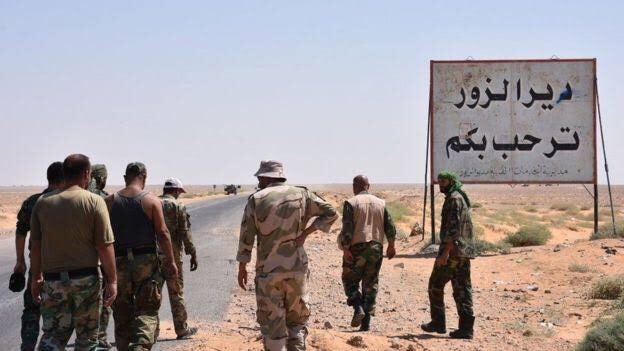This paper addresses verified information which were collected by Justice for Life Organization (JFL) through interviews with witnesses and observing the course of events in Deir Ezzor city, particularly following the control of regular forces on the entire city.
All testimonies and information stated in this paper are about Al Thawara (Al Joura) neighborhood, as it is indicated that 50 percent of the houses are seized by Syrian security members, or militias’ members, or by people close to them. This paper indicates that only 20 percent of the city houses are resided by their owners, while 30 percent of the city houses are rented.
First: Overview:
In June 2012, opposition factions were able to control on neighborhoods of Deir Ezzor city. Since then, the city was divided into two parts; the first one was held by regular forces, and the other was held by armed opposition groups.
The armed opposition sought to advance towards other neighborhoods. The only neighborhoods that were held by the regular forces were Al Joura, Al Qusour, and Harabesh, in addition to Deir Ezzor Airport, Brigade 137, and Talaealbaath camp.
ISIS groups controlled the city neighborhoods that were held by armed opposition factions in July 2014 following battles in the entire province for months.
Second: Introduction:
Regaining Control by Regular Forces:
Syrian regular forces were able to recapture the cities, towns, and villages located in the north of Euphrates River with support of foreign militias and Hezbollah, along with support of the Syrian air force. The battles lasted for six months where the regular forces and their allies used war planes, helicopters, missiles, shells, and artillery. Hundreds of civilians were killed during these battles, along with displacement of more than 200,000 ones from their houses.
The Current Situation in Deir Ezzor:
The regular forces, complementary forces, foreign militias, and Russian forces control over the entire city. There is no unified military and security authoritative body for these forces and militias, which leads to armed fights among them once in a while that result in killed.
The services started to be back to the neighborhoods that were already held by the regular forces, which are Al Joura, Al Qusour, and Harabesh. The neighborhoods that were recently recaptured are still without services.
Third: Military Forces in Deir Ezzor:
Together with the Syrian regular forces and security apparatuses, there many military factions and groups such as;
Islamic Revolutionary Guard Corps, Russian Forces, National Defense (subordinated to the National Defense Administration in Damascus), Hezbollah, Military Security’s Ussud AL Qaed Al Khalid, Republic Guard’s Tribal Forces, Iran-funded Al Baqer forces, Iran-funded and Syrian Military Intelligence’ Al Qudus Brigade, Islamic Revolutionary Guard Corps-funded Liwa Fatemiyoun, Syrian Military Intelligence’ Mohammad Al Nouri Forces, Self Defense Forces of the Arab Socialist Ba’ath Party branch of Deir Ezzor.
Fourth: Seizure of Houses in Deir Ezzor Province:
Returning to the Areas Held by Regular Forces and Their Allies:
The Syrian authorities forced the employees in the public sector to return and start their duties in Deir Ezzor city despite the difficulty for many of them due to unavailability of houses, along with the breakdown of security and fear of detention following indiscriminate arrests, where part of it falls under extortion to get many from the detainees’ relatives.
The houses, of those who cannot return to Deir Ezzor, are exposed to be seized by the members of the Syrian security and regular forces militias along with the foreign militias.
The owners of the seized houses cannot regain them unless they prove their ownership through ownership documents and the attendance of the owner. This may lead thousands of civilians to lose their houses as they lost the official documents in the war time. Additionally, some fear from return to the regular forces held areas.
Dividing Deir Ezzor into Areas of Influence:
The controlling forces in Deir Ezzor divided it into areas of influence and into security branches; Al Joura neighborhood is held by State Security branch, Al Qusour neighborhood is held by Political Security branch. The destroyed neighborhoods are held by security apparatuses as citizens cannot buy, sell, or rent any house unless they have approval by the specialized apparatus.
Liwa Fatemiyoun militias, which include Afghan and Iranian fighters, buying the houses from their owners by force though preventing the owners from returning to their houses or renting them.
Fifth: Seizure Cases in Al Joura and Ghazi Ayyash Neighborhoods:
The Military Security members along with national defense militias seized a group of houses in Al Joura neighborhood as JFL documented six cases.
In the seizure details, members of military security and national defense abused the houses owners as the latter were accused of being ISIS members. They also deported the tenant from other houses. It should be noted that the tenants are renting the houses in a formal and legal way.
The populations in Al Joura neighborhoods said that “Zinga”, who is the bodyguard of national defense militias leader was one of people who seized some houses and gave them to his relatives.
Syrian members of Hezbollah militias seized houses in Ghazi Ayyash, nearby Al Joura neighborhood, as they refuse to leave those houses despite all attempts of the original owners to regain them back.












